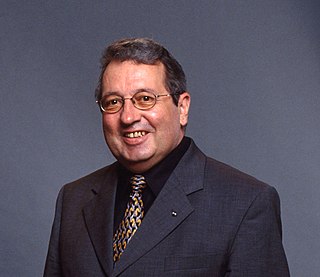
Germany has officially participated in every Eurovision Song Contest since its inaugural edition in 1956, except in 1996 when its entry did not qualify past the audio-only pre-selection round, and consequently was not seen in the broadcast final and does not count as one of Germany's 67 appearances. No other country has been represented as many times. Along with France, Italy, Spain, and the United Kingdom, Germany is one of the "Big Five" countries that are automatically prequalified for the final, due to their participant broadcasters being the largest financial contributors to the European Broadcasting Union (EBU). The final is broadcast in Germany on ARD's flagship channel, Das Erste.
CityDisc is a music, video, video game and book franchise with 33 locations throughout Switzerland. The first locales primarily featured music; as a result, CityDisc is mostly known for its large selection of music, including rarer items such as oldies collections, local folk compilations and video game soundtracks.
The Chemins de fer fribourgeois Gruyère–Fribourg–Morat (GFM) was a railway company in Switzerland. It was established with the merger in 1942 of two standard gauge and one 1,000 mm gauge railways running mainly within the Swiss canton of Fribourg. It was officially called the Compagnie des Chemins de fer fribourgeois. The company also operated numerous regional buses in the same area. After a merger with Fribourg city transport, the company was renamed Transports publics fribourgeois/Freiburgische Verkehrsbetriebe (TPF).
Nicolaus A. Huber is a German composer.

The waste management in Switzerland is based on the polluter pays principle. Bin bags are taxed with pay-per-bag fees in three quarters of the communes. The recycling rate doubled in 20 years due to this strategy. The recycling rate for municipal solid waste exceeds 50 percent.

doual'art is a non profit cultural organisation and art centre founded in 1991 in Douala, Cameroon and focussed on new urban practices of African cities.

Francisco José Conceição Leitão Treichler, better known as Franz Treichler, is a Swiss singer, songwriter, musician, composer and record producer. He is best known as the vocalist and sole consistent member of the Swiss industrial rock band The Young Gods, which he founded in 1985 with sampler player Cesare Pizzi and drummer Frank Bagnoud. Treichler was instrumental in the band's adoption of samplers as a main instrument. He released his solo debut album, Braindance in 2001.
The Neuchâtel Open was a professional golf tournament that was played annually between 1982 and 2007 at Neuchâtel Golf Club in Saint-Blaise, Neuchâtel, Switzerland. It was a 54-hole stroke play tournament.
Jean-François Mayer is a Swiss religious historian, author, and translator. He is also Director of the Religioscope Institute, which he founded. He received his masters degree, and then his doctorate, from the Jean Moulin University Lyon 3 in 1979 and 1984. His writing focuses on religion, with a particular focus on new religious movements and cults, including the Unification Church, the Church of Scientology and the Pilgrims of Arès.
Pierre Mamie was a Swiss prelate of the Catholic Church who served as the bishop of the Diocese of Lausanne, Geneva and Fribourg from 1970 to 1995, following two years as auxiliary bishop there. His earlier career was devoted to teaching at the Fribourg seminary and at the University of Fribourg.

Oskar Leimgruber was a Swiss Politician from the Christian Democratic People's Party (CVP).

Pierre Hemmer, born on March 8, 1950 in Fribourg and died on June 26, 2013 in Mons (Var), was a business leader and executive of the Swiss Confederation, active in particular in the field of the Internet. In 1995, he was, with his firm M&Cnet, the only public service provider in the Canton of Fribourg and many other parts of Switzerland.

La Nouvelle Liberté is a public artwork in the Deido suburb, in Douala (Cameroun).
The Fribourg–Ins railway line is a single-track standard-gauge line in Switzerland operated by Transports publics Fribourgeois. It was built by the Chemin de fer Fribourg–Morat–Anet (FMA).
The FC Basel 1910–11 season was their eighteenth season since the club's foundation. The club's chairman was Ernst-Alfred Thalmann, it was his ninth presidential term, his third term in succession. FC Basel played their home games in the Landhof.

Vincent Ducrot is a Swiss public transport executive. The electrical engineer specialised in information technology was the managing director of Transports publics Fribourgeois (TPF) from 2011 to 2020, before being named as the new CEO of Swiss Federal Railways (SBB) in December 2019. He took up the position on 1 April 2020. The engineer with expertise in project management spent most of his career at SBB, before becoming its CEO in 2020.

The Abbaye de la Fille-Dieu is a Cistercian monastery located near the town of Romont in the Swiss Canton of Fribourg. Founded as a Benedictine priory in 1268, and continuously occupied by a community of nuns since its establishment, the alpine abbey is a Swiss heritage site of national significance. Heavily altered through its history, Fille-Dieu was restructured by economic turmoil, fire, additions and unsympathetic alterations. In 1906 the abbey became affiliated with the Trappists, and between 1990 and 1996 an internationally notable restoration was undertaken, modernising the monastic buildings, restoring the abbey church to its original volume, and preserving its rediscovered medieval murals, with the only contemporary element a suite of stained glass windows commissioned from the British artist Brian Clarke. Further restoration of the abbey continues today.

The Agence nationale pour la gestion des déchets radioactifs (ANDRA), or National agency for the management of radioactive waste is a 'public institution of an industrial and commercial nature' charged with the management of radioactive waste in France.

Hubert Lauper was a Swiss politician of the Christian Democratic Party (PDC).

Nicole Catherine Isabelle Niquille is a Swiss mountain guide, mountaineer and humanitarian. She is the first Swiss woman to become a certified mountain guide and the first woman to reach over 8,000m without supplementary oxygen.











